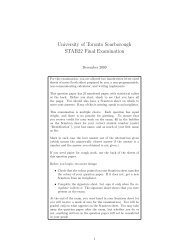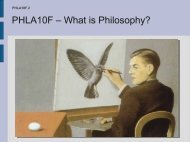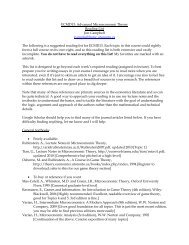Practice problems
Practice problems
Practice problems
Create successful ePaper yourself
Turn your PDF publications into a flip-book with our unique Google optimized e-Paper software.
MGED02: Advanced Microeconomic TheoryIncomplete Information Games<strong>Practice</strong> ProblemsJim CampbellUTSCSeptember 23, 20131 Problems1.1 Bayesian Nash equilibriumTwo armies are considering the invasion of an island. The general of each army can choosefrom two actions: ‘attack’ or ‘withdraw’. Army A is commonly known to be strong, but armyB is either strong with probability 1 or weak with probability 1 , and the general of army A2 2does not know which type army B is.An army captures the island either by attacking when its opponent does not, or byattacking when it is strong and faces a weak rival. If two equally strong armies both attack,neither captures the island. The island is worth a payoff 10 to a general who captures it, butfighting costs 4 for a strong army and 8 for a weak army. There is no cost of fighting unlessthe armies both choose to attack.a) Model this situation as a Bayesian game. What is the strategy space for the general ofarmy A?b) What is the strategy space for the general of army B?c) Define what would constitute a Bayesian Nash equilibrium in this game.d) Show the normal form of this game (e.g. two matrices representing the game, given eachtype of army B).e) Illustrate this game in extensive form.f) If army B was known to be weak, what would be the Nash equilibria in pure strategies?g) If army B was known to be strong, what would be the Nash equilibria in pure strategies?h) Is there a Bayesian Nash equilibrium in which army A plays ‘attack’? If so, characterizeit. If not, explain why not.1
i) Is there a Bayesian Nash equilibrium in which army A plays ‘withdraw’? If so, characterizeit. If not, explain why not.j) If the probability that army B was strong was 3 , would your answers to h) and i) change?4How?1.2 Grab the cakeThere is one piece of cake left, and Ed and Louie would both like some cake. Each mustdecide whether to ‘grab’ the cake or ‘share’.If one player grabs when the other shares, the grabber gets the cake and a payoff of 2 andthe sharer gets no cake and a payoff of zero. If both choose to share they each get half thecake but each receive a payoff of 4, due to being proud of themselves for sharing. If both tryto grab they each get some cake but lose face for being boorish and each receive a payoff of1.a) Write the normal form (matrix representation) of this game. What is the strategy spacefor each player?b) What is the set of pure strategy Nash equilibria? If none exist, explain why.Now consider a different game in which Ed could be one of two types, ‘greedy’ with probability1or ‘polite’ with probability 3 . Ed and Louie again must decide simultaneously whether to4 4‘grab’ or ‘share’, but now Louie does not know what type Ed is.Louie’s payoffs are always as above, but Ed’s depend on his type. They are as above ifhe is polite, but if he is greedy they are different in one case: he really likes to get the wholecake, so if Louie shares and Ed grabs, Ed gets a payoff of 5.c) What is the strategy space for each player?d) Draw an extensive form representation of this game.e) If Louie knew for sure that Ed was greedy, what would be the set of Nash equilibria inpure strategies?f) Back to the situation where Louie doesn’t know Ed’s type. If Louie plays ‘grab’, what isEd’s best response?g) Show that there exists a Bayesian Nash equilibrium in which Louie plays ‘grab’, andcompletely characterize it.h) If Louie plays ‘share’, what is Ed’s best response?i) Show that there exists a Bayesian Nash equilibrium in which Louie plays ‘share’, andcompletely characterize it.j) Show that if the probability that Ed is greedy is 3 , there is no Bayesian Nash equilibrium4in which Louie plays ‘share’ as in i).2
1.3 Weak perfect Bayesian Nash equilibriumConsider the following situation: an entrant is deciding whether to enter a market. It caneither stay out, or it can enter in one of two ways: ‘in 1’ or ‘in 2’. There is a single incumbentfirm, which, if the entrant chooses to enter, must choose whether to ‘fight’ or ‘accommodate’the entrant, but must do so without knowing which of the two entry strategies was playedby the entrant.If the entrant stays out, it earns a payoff of 0 and the incumbent earns 2. If it enters andthe incumbent fights, both earn a payoff of −1. If it enters and the incumbent accommodates,then if the entrant played ‘in 1’ it earns 3 and the incumbent earns 0; if the entrant played‘in 2’ it earns 2 and the incumbent earns 1.a) Illustrate this as an extensive form game. How many subgames are there?b) Illustrate the normal form of this game.c) Explain why there are two pure strategy Nash equilibria: (out; fight) and (in 1; accommodate).d) Are these pure strategy Nash equilibria subgame perfect? Why or why not?e) Completely characterize a weak PBE with (in 1; accommodate). In particular, whatbeliefs must the incumbent hold at the information set after the entrant enters?f) Show that there exists no weak PBE in which the players play (out; fight).Consider a different version of the same setting with different payoffs following entry. Nowif the entrant enters with ‘in 1’ and the incumbent fights, the entrant earns −3 and theincumbent −1. If it enters with ‘in 1’ and the incumbent accommodates, the entrant earns1 and the incumbent −2. If it enters with ‘in 2’ and the incumbent fights, the entrant earns−2 and the incumbent −1. If it enters with ‘in 2’ and the incumbent accommodates, theentrant earns 3 and the incumbent 1.g) Redraw the extensive form with these new payoffs.h) Illustrate the normal form of this game.i) Explain why there are two pure strategy Nash equilibria: (out; fight) and (in 2; accommodate).j) Completely characterize a weak PBE with (in 2; accommodate).k) Completely characterize a weak PBE with (out; fight).l) Show that the weak PBE in k) is ruled out by forward induction reasoning.3
2 Revision conceptsDefine:1. “Evolutionarily stable strategy”2. “Nature”3. “Type”4. “Bayesian Nash equilibrium”5. “Weak perfect Bayesian equilibrium”6. “System of beliefs”7. “Forward induction”4



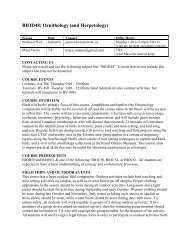
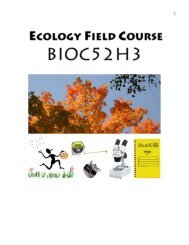


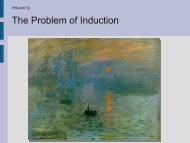
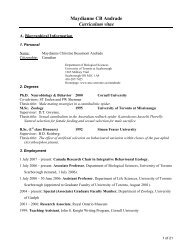
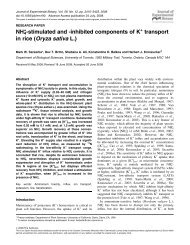
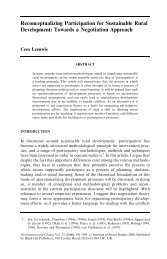
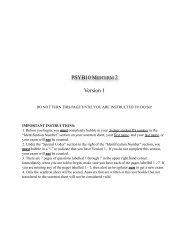
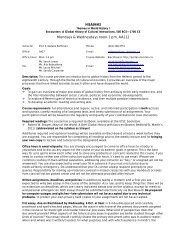
![[Enter course name - Syllabus] - University of Toronto Scarborough](https://img.yumpu.com/50068522/1/190x245/enter-course-name-syllabus-university-of-toronto-scarborough.jpg?quality=85)
